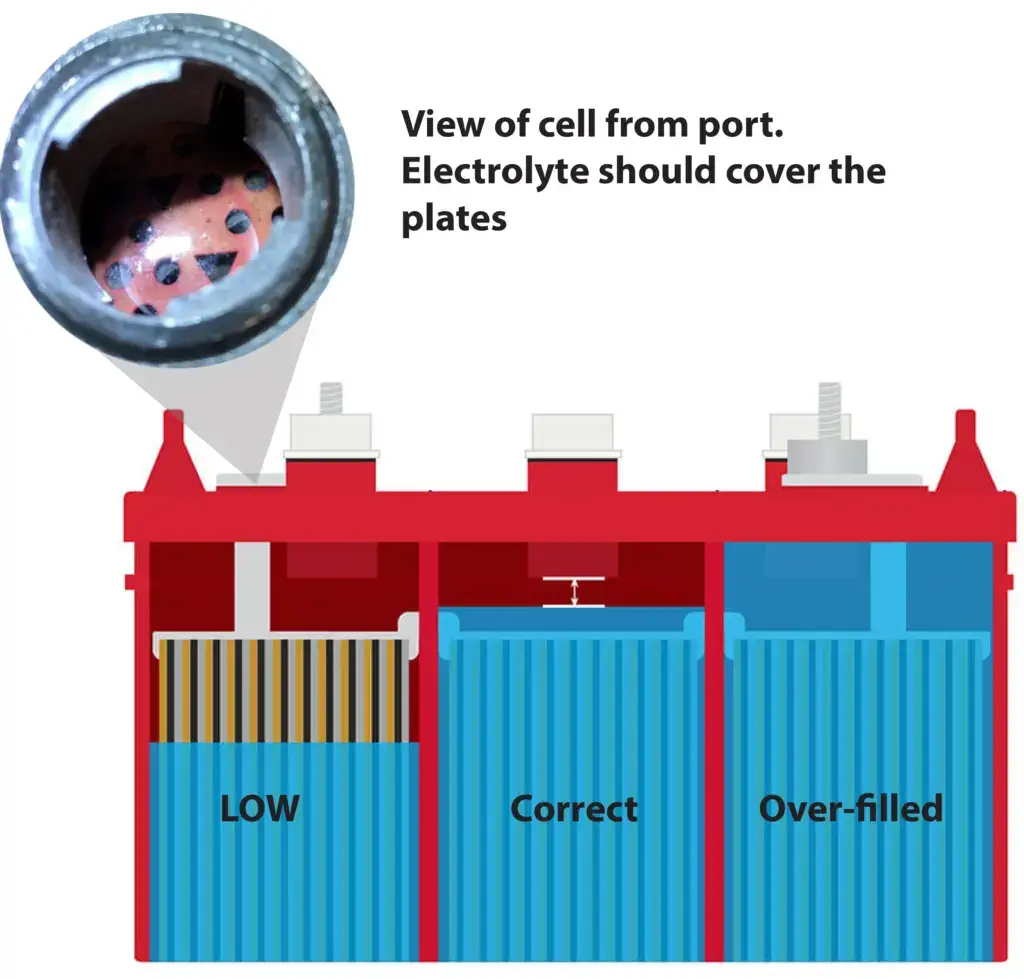Top off a car battery
How to top off battery fluid
Do you need to top off battery fluid? If so, how to do it.
What fluid to add to your car battery
The electrolyte water-to-acid ratio 80:20. If you’ve run down the battery and charge it heavily, the electrolyte can boil and evaporate off some of the water. In addition to heavy charging, high heat can cause water evaporation. If the electrolyte level falls below normal levels you should add distilled water to bring the level back to normal. After adding distilled water, you should drive the vehicle. NEVER add battery acid to refill a car battery.
Most car batteries sold today are maintenance free, even if they have vent caps
Most car batteries sold today are made with calcium lead plates that dramatically reduce out-gassing and water evaporation during charging. Some people think that presence of vent caps means that the battery isn’t maintenance free. That’s not true.
Why Do Some Batteries Need to Be Topped Off?
Without getting too technical, it all depends on a battery’s chemical makeup or design. As a non-maintenance free (NMF) battery discharges and recharges, battery fluid changes to a gas and evaporates. This requires the battery fluid to be refilled from time to time. Conversely, maintenance-free batteries are engineered to maintain battery fluid levels without refilling and cannot be checked, even if you wanted to.
Temperature also has a major impact on why NMF batteries need topping off. Summer heat accelerates the evaporation process. In winter, cold weather lowers battery power. Coupled with motor oil thickening from lower temperatures, the battery works harder to start your car. To quickly restore battery power, the alternator charges the battery at a higher rate for a longer time. Excess charging overheats the battery, causing the battery fluid to decompose, dry up and require topping off on occasion.
Not topping off battery fluid in an NMF battery ultimately leads to premature battery failure.
How to Tell if your battery needs to be topped off
Battery “eye”
Some batteries have a clear battery indicator “eye” on the top that glows green if the water level is good and fully charged, and goes dark if the battery needs fluid or is discharged. If it’s yellow, it usually means that the battery fluid level is low, or the battery is defective. (Battery manufacturers recommend replacing maintenance free batteries that have low battery fluid levels.)
A battery with low battery fluid levels also gives signs you shouldn’t ignore. Slow crank/no crank starting condition, dimming lights, alternator or battery light flickering on, other electrical problems or even the Check Engine Light illuminating can point to battery problems.
Remove fill caps
Non-maintenance-free batteries can also be checked by opening the fill caps on the top of the battery and looking inside. The fluid should be about 1/2- to 3/4-in. above the internal “plates,” or about 1/2- to one-inch from the top of the battery (just to the bottom edge of the fill hole). If the fluid is below that, it needs to be topped off.
A 12-volt battery contains six “cells,” with each cell containing a set of “plates” (electrodes). Looking down the fill hole of each cell you can see the top of these plates. Usually grayish in color, they resemble a row of heavy-duty construction paper folded accordion style. A chemical reaction between the battery fluid and plate material produces the electricity that flows out of a battery.
How to Top Off a Battery
If you’ve determined that your battery fluid is low, follow these steps:
Make sure the battery is completely charged
If you’re unsure of the state of charge and there is no indicator eye, use a voltmeter to check the voltage across the terminals (12.6 volts with the engine off). Or check the battery fluid specific gravity (pH) with a battery hydrometer. (A fully charged battery should have a pH reading of 1.265 or higher.)
Make sure the engine is off and cool
Clean the case with a brush and weak solution of 1/4-cup baking soda and one-quart clean water, then flush with clean water before removing the filler caps. This helps keep dirt and gunk out of the battery.
Remove the filler caps. Use a flat plastic scraper to help pry off a three-cell cap — never use anything containing metal.
Carefully and slowly (do NOT splash) pour distilled water into each cell fill hole as needed. ONLY use distilled water because tap water contains minerals that will harm your battery. You can use a small, clean plastic measuring cup or turkey baster to control the amount and flow of the water into the battery.
Measure carefully. Overfilling will dilute the electrolyte, causing it to expand, damaging the battery. Plates that dry out become overly acidic and form sulphate crystals that accumulate in the battery. Sulfate build-up restricts current flow and shortens battery life.
Re-cap the fill holes.
Remember, even well-maintained batteries do not last forever. Depending on the climate and driving conditions, expect to replace your battery every three to five years. Be sure to dispose of your old car battery safely.
©, 2022 Rick Muscoplat
Posted on by Rick Muscoplat
